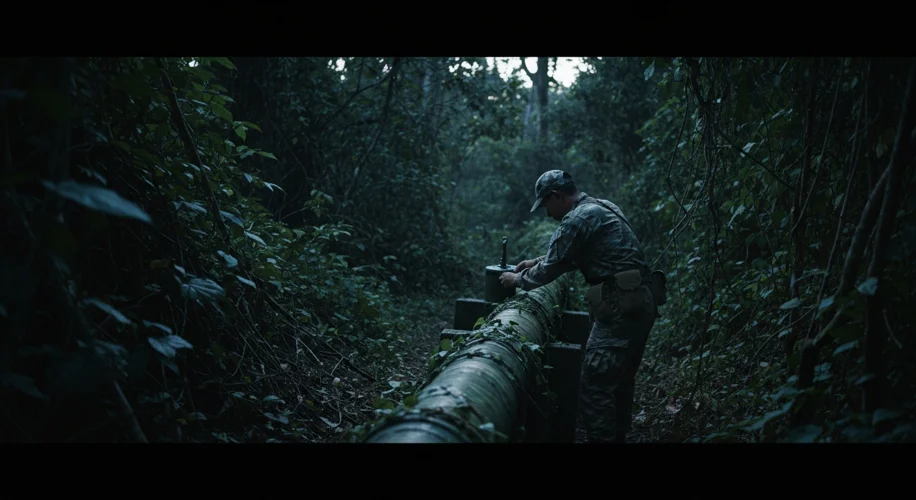The roar of engines, the thunder of artillery, the relentless march of armies – all are powered by a hidden, vital force: fuel. In the theatre of war, cutting off this lifeblood has always been a strategic imperative. Throughout history, intrepid saboteurs and cunning strategists have recognized that while armies may fight with steel and gunpowder, they run on oil. The targeting of military fuel pipelines, a seemingly mundane yet critical infrastructure, represents a fascinating and often decisive facet of covert warfare.
In the crucible of conflict, the flow of fuel is as crucial as the flow of information. When a nation’s military machinery grinds to a halt, its offensive capabilities crumble, and its defensive perimeters become porous. This understanding has driven covert operations throughout various wars, transforming innocuous pipelines into prime targets for sabotage.
One of the most poignant examples of fuel pipeline sabotage occurred during the Vietnam War. The Ho Chi Minh Trail, a legendary network of jungle paths and hidden routes, was not just for troop movements; it was a meticulously engineered logistical artery that supplied the Viet Cong and the North Vietnamese Army with everything they needed, including vast quantities of fuel. While the United States employed extensive aerial bombing campaigns, including Operation Popeye which used cloud-seeding tactics to disrupt trails, the sheer scale and clandestine nature of the supply chain made it incredibly difficult to interdict completely. However, smaller-scale sabotage, often carried out by local sympathizers or specialized units, targeted fuel depots and smaller distribution lines. Imagine a lone operative, deep in the humid, insect-ridden jungle, meticulously placing a small explosive charge on a hidden fuel pipe, the faint hiss of escaping gasoline a siren song of success. The disruption, though perhaps localized, could significantly hamper enemy operations in a particular sector, forcing them to reroute, repair, or even abandon vital positions.

During World War II, the importance of fuel infrastructure was amplified by the mechanized nature of warfare. Allied forces, particularly in the European theater, recognized the strategic value of German oil refineries and fuel storage facilities. While direct pipeline sabotage was less common due to the extensive nature of German infrastructure and the primary focus on bombing industrial sites, the concept of denying fuel was paramount. The famous “Red Ball Express,” a massive truck convoy system established by the Allies after the Normandy landings, was a testament to the sheer volume of fuel required to keep the advance moving. Had German saboteurs been able to effectively target the fuel depots and supply lines feeding this operation, the Allied advance could have been dramatically slowed, if not halted.
Beyond direct physical destruction, other forms of sabotage have targeted fuel flow. In periods of heightened tension or proxy conflicts, the intentional release of fuel from pipelines, or the introduction of contaminants, could render vast reserves unusable, creating a silent, insidious form of warfare. This approach, while less dramatic than an explosion, can have equally devastating strategic consequences, forcing the enemy to expend valuable resources on cleanup and resupply.
The motivations behind such acts are manifold: to cripple an enemy’s military might, to disrupt their economic capacity, or even as a form of psychological warfare, demonstrating the vulnerability of even the most robust systems. The actors involved range from highly trained special forces units on clandestine missions to local resistance fighters acting with limited resources but profound local knowledge. Each instance, whether a grand, state-sponsored operation or a small act of defiance, underscores a fundamental truth: control the fuel, and you control the war machine.
The impact of successful pipeline sabotage is immediate and far-reaching. Units become stranded, offensives falter, and defensive lines buckle. The psychological toll on an enemy, constantly aware that their lifeblood can be severed at any moment, is also significant. It forces a diversion of resources towards security and repair, away from direct combat operations. Furthermore, the long-term consequences can reshape the strategic landscape, influencing the duration of conflicts and the ultimate victor.
In conclusion, the history of military fuel pipeline sabotage is a testament to the ingenuity and ruthlessness of warfare. It highlights how the most critical vulnerabilities often lie not in the obvious weapons, but in the unseen arteries that sustain them. From the jungles of Vietnam to the industrial heartlands of Europe, the silent destruction of fuel infrastructure has played a vital, albeit often overlooked, role in shaping the course of history, reminding us that in war, as in life, the flow of energy is everything.

